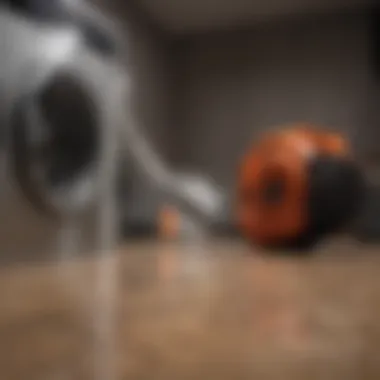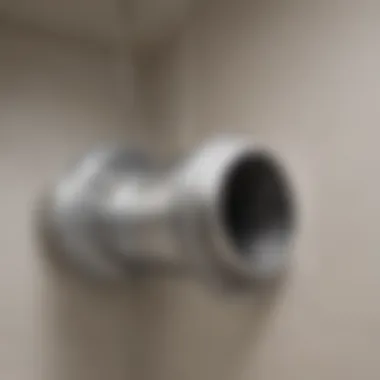A Comprehensive Guide to Cleaning Your Dryer Vent


Intro
A dryer vent plays a crucial role in the overall efficiency of your dryer. When it gets clogged, it can lead to poor performance, increased energy bills, and even fire hazards. Therefore, maintaining a clean dryer vent is essential. Using a leaf blower can be an effective strategy for this task.
This guide examines the steps needed to clean your dryer vent using a leaf blower. The key aspects include necessary tools, safety precautions, and techniques to ensure thorough cleaning. We will also address the implications of regular maintenance and its benefits for your appliance's longevity and safety.
Knowing the right approach can make a significant difference. Whether you are a novice or someone with prior experience in home maintenance, this guide will provide useful information. Now let's dive into the preparations before we start the cleaning process.
Prolusion to Dryer Vent Cleaning
Cleaning your dryer vent is a critical yet often overlooked home maintenance task. Many homeowners do not realize that regular vent cleaning can prevent numerous issues, including longer drying times and increased energy costs. As dryers accumulate lint, the airflow in the vent becomes restricted. This restriction affects not only the performance of your dryer but also poses serious safety risks.
The Importance of Dryer Vent Maintenance
Regular maintenance of your dryer vent holds significant value for both functionality and safety. When these vents are clogged, the efficiency of your dryer reduces, requiring more energy to operate. According to the U.S. Fire Administration, dryer vents that are not properly maintained can lead to fire hazards. Keeping your vents clean ensures that your appliance operates at its optimal level, which can prolong its lifespan. An efficient dryer translates into lower energy bills and reduced wear on the machine.
Risks Associated with Clogged Dryer Vents
Clogs in dryer vents can lead to a myriad of problems. Firstly, the most pressing concern is the risk of fire. Lint is highly flammable and can ignite if it gets too hot. Beyond that, clogged vents can cause mold growth due to the moisture trapped in the line. Mold not only damages the system itself but can also pose health risks to occupants. It is essential to recognize signs of blockage, such as excessive drying times or an overheated dryer, to mitigate these risks. Thus, understanding the significance of dryer vent cleaning is not just about efficiency; it is about safeguarding your home and well-being.
Understanding Dryer Vents
When considering the maintenance of your home, understanding dryer vents is crucial for several reasons. Dryer vents play a critical role in the efficient operation of your dryer. They are responsible for carrying moisture, heat, and lint away from the appliance, preventing potential fire hazards and reducing energy consumption.
A comprehensive grasp of how dryer vents function helps homeowners recognize the importance of regular cleaning and upkeep. With this knowledge, it becomes easier to identify when troubleshooting is necessary. Furthermore, recognizing the components and materials involved in dryer vent construction can aid in deciding the best cleaning approach.
Composition and Functionality of Dryer Vents
Dryer vents are designed to discharge hot, moist air generated during the drying process. Typically, they consist of a duct made from flexible or rigid materials. The functionality of the dryer vent is to transport exhaust air from the dryer outside the home. Most are installed with a slight incline to ensure proper airflow and prevent backdraft.
Key components include:
- Duct: The main channel through which exhaust air travels. It can typically range from 4 to 6 inches in diameter.
- Termination Hood: This is the exterior opening of the duct. It often has a flap that opens during operation and closes when the dryer is off, preventing pests from entering.
- Clamps and Connectors: These secure the duct in place and prevent air leaks.
Having functional dryer vents means enhanced safety and efficiency in laundry practices. If they become clogged, the risk for overheating and potential fires increases significantly. Understanding how these components work together can guide you in maintaining them in optimal condition.
Common Materials Used
Dryer vents are made from various materials, each offering unique benefits and considerations. Choosing the right material is essential for long-term performance and safety. Here are some common materials:
- Metal Ductwork: Aluminum or galvanized steel is often used for its durability and resistance to damage. They provide smooth interior surfaces that allow for efficient airflow.
- Flexible Plastic Ducts: While these are more affordable and easier to install, they are not recommended for extended lengths. They can be prone to kinking, which obstructs airflow.
- Semi-Rigid Ducts: These combine the benefits of metal and flexible materials. They maintain shape while providing some flexibility in installation.
Choosing the right materials affects not only the functionality of your dryer vent but also its longevity. Regular assessment of duct materials can guide decisions on when to replace them for enhanced safety and efficiency.


Why Use a Leaf Blower?
Using a leaf blower for cleaning your dryer vent is a practical choice for many homeowners. This method combines efficiency and effectiveness, addressing the core needs of vent cleaning without the complexities often associated with traditional tools. A leaf blower harnesses powerful air streams to dislodge lint and debris, ensuring a thorough clean of the vent system.
Advantages of Using a Leaf Blower
Employing a leaf blower comes with several advantages:
- Powerful Airflow: Leaf blowers generate substantial airflow, which is essential for moving lint buildup and debris out of the venting system. This high velocity ensures that clogs are effectively cleared.
- Time Efficiency: Compared to manual cleaning tools, a leaf blower significantly reduces the cleaning time required. It allows you to accomplish the task in a fraction of the time, making it ideal for those with a busy schedule.
- Accessibility: With the right attachments, leaf blowers can easily reach vent sections that are often hard to access. This means you can clean the entire vent length without the need to disassemble parts of your dryer.
- Cost-Effectiveness: A leaf blower can be a one-time investment, offering long-term benefits. The costs associated with professional vent cleaning can add up, while maintaining your dryer vent with a leaf blower can spread out initial costs over time.
- Ease of Use: Operating a leaf blower typically does not require specialized skills. Most homeowners can manage it comfortably without extensive training or preparation.
Comparative Analysis with Other Methods
When evaluating the leaf blower against other vent cleaning methods, several key differences emerge:
- Manual Cleaning Tools: Traditional tools like brushes and rods require significant manual effort. They may not generate the same level of airflow as a leaf blower, making them less efficient in removing stubborn lint.
- Professional Services: While hiring professionals ensures a thorough cleaning, it can be expensive and requires scheduling appointments. Using a leaf blower allows for on-demand cleaning, fitting into your timetable without additional costs.
- Vacuum Cleaners: Although some vacuum systems can assist in vent cleaning, they often lack the power needed to thoroughly dislodge debris. They also require the use of electrical outlets, which may not be accessible in all cleaning scenarios.
Ultimately, the leaf blower stands out as a highly effective and user-friendly option for dryer vent maintenance. Combining power, efficiency, and cost benefits makes it a strong contender in vent cleaning practices.
Preparing for the Cleaning Process
Preparing for the cleaning process is a vital stage in the efficient cleaning of your dryer vent. A well-thought-out preparation can save time and enhance the effectiveness of the whole operation. Without the right tools and precautions, one may face difficulties that could jeopardize both safety and success in cleaning. Therefore, understanding what tools to gather and what safety measures to follow is essential.
Gathering Necessary Tools
Leaf blower specifications
When selecting a leaf blower for cleaning dryer vents, certain specifications play a critical role. The motor power is one key aspect to consider. A leaf blower with a motor of at least 2000 watts would ensure adequate airflow to effectively dislodge lint and debris within the vent.
Another important characteristic is weight. A lightweight leaf blower allows for easier maneuverability, minimizing fatigue during extended usage. Additionally, choose a blower with variable speed settings; this feature provides flexibility in controlling airflow based on the severity of clogs.
Options like the Echo PB-770T offer a powerful motor and adjustable speeds. These features contribute to its popularity among homeowners. However, its noise level could be a disadvantage for those who prefer quieter options.
Vent cleaning attachments
Vent cleaning attachments for leaf blowers are specifically designed to enhance the cleaning process. These attachments typically consist of flexible, extendable hoses that can reach deep into the ductwork. Their primary purpose is to push lint and debris toward the exit.
A notable characteristic of these attachments is their compatibility with various leaf blower models. This factor makes them a popular choice for users looking for convenience. The unique feature of a multi-piece design allows for various lengths, enabling access to longer dryer vent runs.
Nevertheless, ensure that the attachment fits securely on your leaf blower to avoid any disconnection during use. The lack of a secure fit may lead to ineffective cleaning or even potential damage to the blower.
Safety Precautions to Consider
Protective gear
Using protective gear is fundamental during this cleaning process. Lint and debris can pose respiratory hazards or even cause skin irritation. Wearing a mask, such as an N95 respirator, helps to filter out fine particles, ensuring safer breathing conditions.


Other protective gear should include gloves and safety goggles. Gloves prevent injuries and maintain cleanliness while handling equipment. Safety goggles protect the eyes from dust and debris flying around during the cleaning process. This layered approach to safety guarantees that the cleaning remains a secure practice.
Electrical safety measures
Electrical safety measures are vital when dealing with appliances and electrical tools. First, always unplug the dryer before initiating any cleaning process. This precaution eliminates the risk of accidental activation while working.
Additionally, avoid using wet hands on electrical components. Dry conditions help reduce the likelihood of electrical shocks. Implement proper grounding measures if using a leaf blower that requires a power outlet. Ensuring all electrical connections are dry and secure contributes to an overall safer environment during the operation.
"Safety should always be a priority when engaging in home maintenance tasks, especially those involving electricity and potentially hazardous materials."
In summary, preparing effectively for the dryer vent cleaning process involves careful planning regarding tools and safety measures. Selecting the right leaf blower and attachments, along with appropriate protective gear, contributes to smoother operation and enhanced efficacy. Whether you are a novice or seasoned homeowner, taking these points into account is essential for success.
Step-by-Step Guide to Cleaning the Dryer Vent
Cleaning your dryer vent effectively is vital for maintaining dryer efficiency and safety in your home. Step-by-step guidance allows you to follow a systematic approach, reducing the risk of error and ensuring thorough cleaning. Each phase is crucial, from disconnecting the dryer to verifying that the vent system is clear of blockages.
Disconnecting the Dryer
The first step in cleaning the dryer vent involves safely disconnecting the dryer from the power source. Before proceeding, ensure the dryer is turned off and unplugged. This prevents any accidents during the cleaning process. Additionally, if you have a gas dryer, turn off the gas supply as well. Using a flashlight can help in seeing the back of the dryer clearly. It is important to keep the area around the dryer neat to avoid unnecessary hazards.
Accessing the Vent
Once the dryer is safely disconnected, the next step is to access the dryer vent. This often involves removing the vent duct from the back of the dryer. Usually, a clamp holds it in place. Using a screwdriver, loosen this clamp effectively. After removing the duct, look at the vent leading outside. You may need to disconnect this as well to achieve a complete cleaning. This access allows you to perform a comprehensive inspection and cleaning of the entire vent system.
Using the Leaf Blower Effectively
Utilizing a leaf blower provides an efficient method for cleaning your dryer vent. This section will discuss implementing this tool for optimal performance in removing lint and debris.
Techniques for Optimal Airflow
Optimal airflow is essential when using a leaf blower. Proper positioning of the leaf blower in relation to the vent is important. Use the highest power setting available on the blower model. Keep the nozzle directed towards the vent opening to create strong airflow. This direct approach helps in dislodging stubborn clogs effectively. One key characteristic of employing optimal airflow techniques is the high performance in clearing lint build-up. However, it is crucial to avoid blowing too forcefully which might damage the vent material.
Addressing Stubborn Clogs
Sometimes, you may encounter stubborn clogs within the dryer vent system. These clogs are more than just minor lint buildup and require additional effort and technique. It's beneficial to regularly check for any known trouble spots in your vent system, where clogs are known to develop. For these areas, you may need to repeat the air blasting process several times. This can help loosen more tenacious lint and debris. While using a leaf blower makes the process easier, maintain caution if the vent is extended or contains bends, as it may still be difficult to fully remove clogs. An additional inspection after blowing air through the vent can assist in ensuring that no blockages remain.
Post-Cleaning Procedures
After completing the cleaning process of your dryer vent using a leaf blower, it is essential to follow specific post-cleaning procedures. These steps ensure that everything is reassembled correctly and that the dryer operates safely and efficiently.
Reconnecting the Dryer
Once you have finished cleaning, it’s time to reconnect the dryer. This task seems straightforward but requires attention to detail. First, ensure that the vent is free from debris. Check that the hose from the dryer to the vent is intact, without any kinks or damage. Secure the vent hose tightly to avoid air leakage. This is important because any improper connection can reduce the efficiency of your dryer, leading to increased drying times and potential overheating.
You should also ensure that the dryer itself is in a stable position. After reconnecting, make a final visual inspection to confirm that all components are aligned and securely attached.


Testing Dryer Functionality
Testing the dryer’s functionality after reconnecting is a crucial step. This process helps verify that the cleaning was successful and that the dryer is working properly. To do this, begin by running a small load of laundry. Monitor how the dryer operates during this cycle. Pay attention to the following:
- Drying Time: Does the laundry dry within the expected timeframe?
- Heat: Is the dryer producing adequate heat?
- Noise Levels: Are there any unusual sounds that could indicate a problem?
If the dryer performs optimally, this is a positive sign that your cleaning efforts were effective. However, if you notice any signs of malfunction or inefficiency, check the connections and consider repeating the cleaning process if necessary.
Regular maintenance, including efficient cleaning, ensures the proper functionality of your dryer and significantly improves its lifespan.
Overall, post-cleaning procedures play a vital role in ensuring your dryer operates efficiently and safely. By carefully reconnecting the unit and testing its functionality, you not only confirm your efforts but also enhance the longevity and performance of your appliance.
Maintenance Tips for the Future
Cleaning your dryer vent using a leaf blower is just part of a larger commitment to home maintenance. Understanding how to keep your dryer vent in good working condition can save you from costly repairs and safety hazards. With regular attention and proactive strategies, you can keep your dryer efficient and effective.
Regular Inspection Schedule
Establishing a regular inspection schedule is vital for maintaining your dryer vent. Homeowners should check their vents at least twice a year. This schedule helps to identify blockages and potential issues early. A good practice involves looking for lint buildup in the vent and around the dryer. Additionally, be aware of any signs of wear in duct materials.
Tips for a useful inspection include:
- Look for visible lint at the dryer exit.
- Inspect the ductwork for any bends or kinks.
- Listen for unusual noises during the drying cycle. An anomaly might highlight airflow restrictions.
Routine checks allow for immediate action against developing problems. By keeping a calendar or setting reminders, maintaining a schedule becomes easier and more effective.
Signs Your Vent Needs Attention
There are several indicators that may suggest your dryer vent requires immediate attention. These signs can save you from extensive damage and hazards:
- Drying times increase: If clothes take longer than one cycle to dry, it often indicates a blockage.
- Burning smell: This potentially dangerous sign indicates overheating.
- Vent exhaust feels warm: After operating, check the temperature. It should be warm but not excessively hot.
- Increased lint buildup: If you're finding lint around your dryer or in the room, your vent is likely clogged.
Regularly monitoring these symptoms can prevent dryer fires and prolong appliance life.
Addressing these issues promptly enhances the longevity and efficiency of your dryer. If you notice any of these signs, it's time to conduct a thorough cleaning or seek professional help.
Closure
Maintaining the dryer vent is critical for both safety and efficiency in any household. Clogged vents not only hinder the effective operation of dryers but also pose significant fire risks. By cleaning the dryer vent regularly, homeowners can prevent dangerous buildups of lint and other debris that may lead to overheating and potential fires.
The process described in this article demonstrates the practicality of using a leaf blower for efficient vent cleaning. This method stands out due to its effectiveness in dislodging lint and debris that traditional cleaning tools might miss. Furthermore, it is a cost-effective solution that many homeowners can implement without professional assistance, making it accessible for everyone.
Key Benefits of Dryer Vent Maintenance:
- Increases energy efficiency by ensuring proper airflow.
- Reduces drying times, saving not only time but also energy.
- Enhances the lifespan of the dryer, translating to cost savings.
It is important to recognize the signs of a clogged vent. Homeowners should be alert to any unusual changes in dryer performance, such as longer drying times or excessive heat. Proactive inspection and maintenance can significantly reduce the risk of fire and ensure that the dryer operates smoothly.
In summary, regular dryer vent maintenance using tools like a leaf blower is essential. Not only does it mitigate risks associated with fire hazards, but it also promotes a more efficient and effective appliance operation. By prioritizing these practices, homeowners can assure the safety and functionality of their dryers for years to come.
"An ounce of prevention is worth a pound of cure." It holds true in the context of dryer maintenance.



